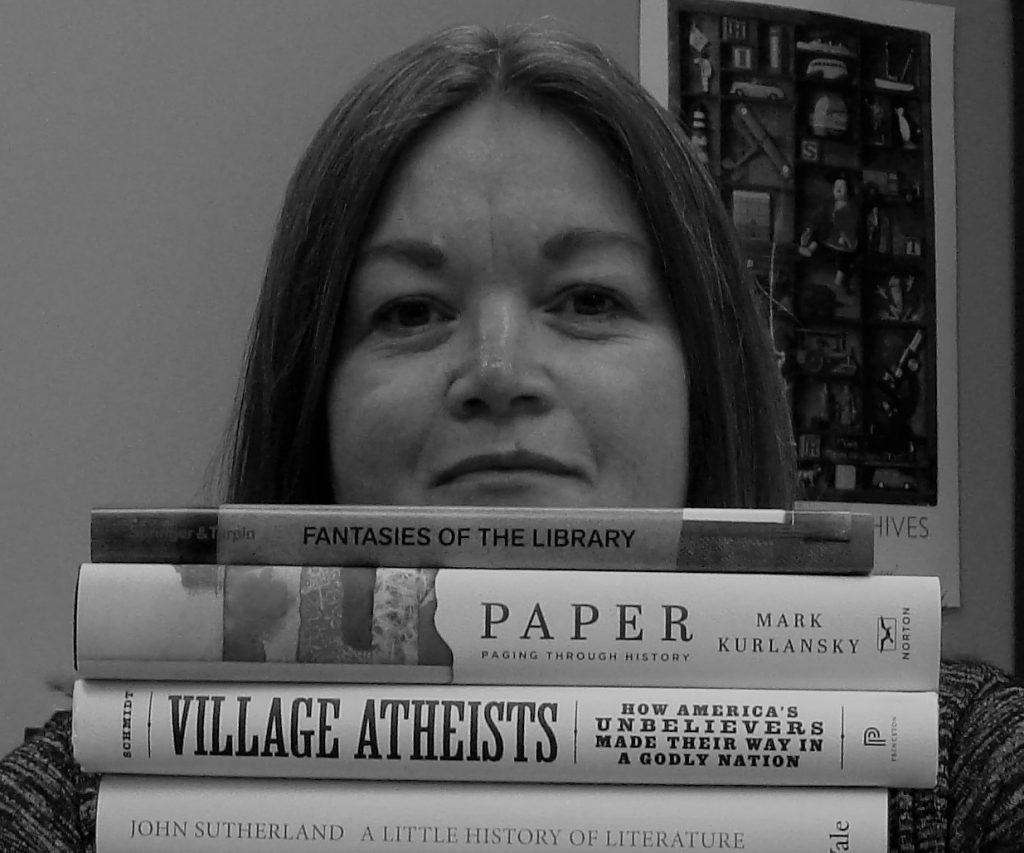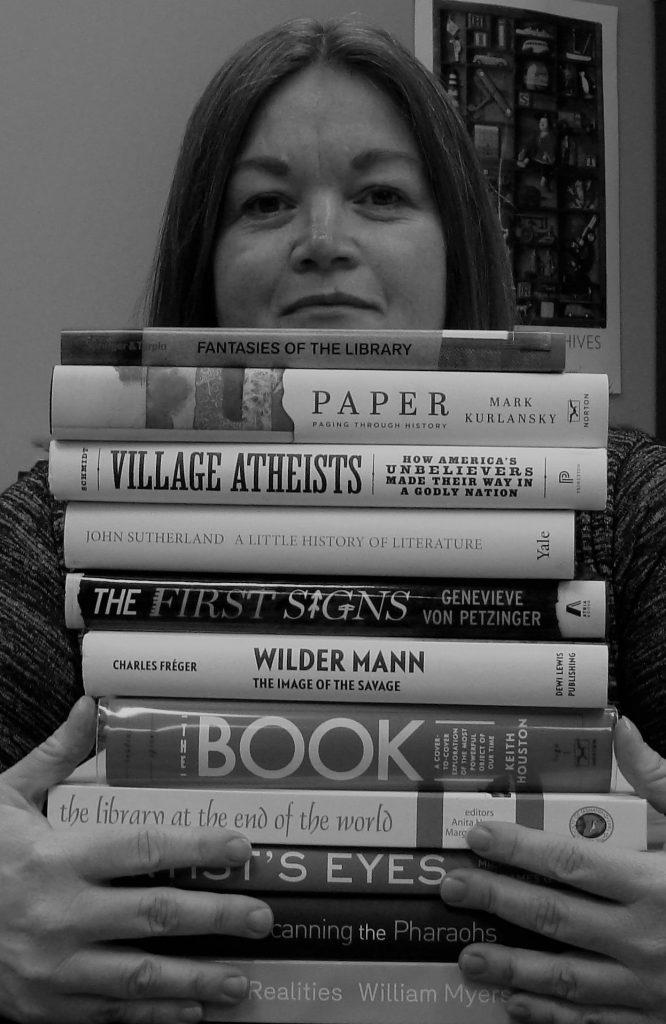Your story in a few lines, starting from the very beginning – birth, family and the first choices and steps
I was born in Adelaide, South Australia to Dutch migrant parents – they migrated to Australia in the 1950s, with their four young sons. My first career was in the field of disability services, specifically working with people with intellectual disability. In 1996, my husband and I decided to move to Hobart, Tasmania and in the process changed our career paths. I retrained in Library and Information Studies and began working in several different libraries in Hobart, as well as providing technical and teaching support to the Library course at TAFE Tasmania. In January 1999 I gave birth to my son. In November 1999 I began to work at the small Moorilla Museum of Antiquities. Owned by David Walsh, this would eventually grow into the Museum of Old and New Art (Mona), where I now manage the Mona Library.
You as reader: which ways, which places and which needs?
As a reader, I have very broad tastes – I enjoy everything from murder mysteries, science fiction and fantasy, through to biographies, history, science, art and popular culture. I try to discipline myself by rotating through genres – read a fiction book, then a popular non-fiction book, then something more academic before rewarding myself with more fiction! I can read anywhere, anytime and reading is what keeps my brain active.
The world of publishers today is slow and furious at the same time, also happening in a plurality of means (instant books, online pdf with multimedia teasers): what happened to your profession of librarian – in maybe the most interesting private museum of the world, the Museum of Old and Modern art (Tasmania)?
You hear a lot about how libraries must change, and librarians must change too. To be honest, I find this odd and amusing at the same time – libraries and librarians have always had to change. They are very good at it because they have the skills to evaluate information and turn it into useful knowledge – and often into wisdom. It’s very narrow to think of libraries as only being about books – they are not and never have been. The very first libraries were small chambers filled with clay tablets, later ones had scrolls, then codices and books and now also computers and electronic tablets (something of a full circle). Our profession is all about storing information (in any format) and making it useful – plurality is our normal. The Mona Library is special because at its heart it is very traditional: a wonderful collection of books. However, we also use the latest technology to carry out research and to manage our collection. We are lucky to experience many of the best aspects of library work. Every day brings new challenges and excitement.
Which is your most incredible amazement coming from the incredible figures of everyday audience the library hosts?
The library itself only sees a fraction of the museum visitors (our long-term average is around 10%). One of the most amazing things to me is how many people have no idea that museums and galleries have libraries. We spend a lot of time each day explaining to visitors why museum libraries exist. On the other hand, many of the visitors who do come to the library enjoy the collection and it’s wonderful to get their positive feedback. The best thing is when you hear library visitors say they feel they have gained some insight into Mona and David’s ideas by looking at the library collection.
Your library is strongly theme-based and ruled by the passions of its founder, the MONA inventor David Walsh, who was loving public libraries and spent most of his teenage to get his soul food by public readings (being at that time not enough wealthy to buy all the books he, omnivore, was able to read). It is a memento mori, a unique example and ‘case’ among the libraries of art museums, we think. And, all this said, it is even more seminal than any free resource to improve our life.
How do you face with this everyday to find the right way to alphabetize readers in this kind of library and, more in general, to let be people more aware of the power of the written words?
As I’ve said, we do spend a large part of our day explaining the origin and function of the library to visitors. Usually we engage them in thoughtful conversation and this seems to work very well. Sadly, many people seem to lose touch with libraries and books after they leave school, and it is nice to encourage them to explore our shelves in the hope it might inspire them to take up reading again. We welcome and encourage school groups and researchers to use the library and help them in any way we can.
What place creative writing has (or should have) in your domestic and private life? Are you also a writer?
Sadly, I don’t spend much time writing. Creative writing should play a much bigger role in my private life – but then I would have to spend less time reading!
Apart from working with books everyday, are you also a collector of writings and printed objects yourself?
My bookshelves are overflowing and I have four piles of books waiting for me to read them – immediately! I try to go to any book launches that happen in Hobart and I enjoy collecting signed editions of new books in this way. By going to as many book launches as possible, I also am exposed to books on subjects beyond my usual choice.
Which is the most important achievement after so many years at MONA Library?
When I first started working with the library collection, it numbered around 1200 titles. Today it has 11,800 titles and another 2,000 titles waiting to be processed and catalogued. It is not the numbers as such that matter, but with this sort of volume you can see the collection develop a personality and life of its own. I’m really pleased to see the collection grow and be safe and available to people. I’m also glad that the collection still strongly reflects David Walsh’s interests.
Describe a fantastic happening you, as person, have had in recent time?
Personally, I’d have to say my son turning 18 and being accepted into university was absolutely wonderful. Professionally, the opening of Mona’s exhibition, On the Origin of Art, was amazing. The exhibition itself is brilliant and the opening night was fun and fantastic!
What your city is giving to you and vice versa?
Hobart is a safe and beautiful place to live, great people, food and culture. It’s also very relaxed which means a lot to me. It gives me peace, I give it devotion.
Can you share your favourite cooking passion?
Seafood risotto or an Asian style stir fry with lots of fresh green vegetables. Platters with a little bit of everything to share!
Which is your favourite wine or drink?
I enjoy sampling different wines – and one of the benefits of living in Tasmania is that there are many wines to try! Prosecco has become very popular in Australia recently and it’s fun to explore all the different types that are now available.
Which is your music with you now?
I have a few different albums playing in my car right now. Talking Heads, Elbow, Caro Emerald, Ben Salter, Twenty-One Pilots and Macklemore.
In which way do you try to live “slowly”, if you like to do so, in a city as yours?
Hobart is all about living slowly – relax, enjoy, breathe. I live in one of the seaside suburbs and can always relax by listening to the waves break.
Which is a talent you have and the one you miss?
I have an excellent memory and like problem solving. I wish I had learned to play the piano or guitar when I was young.
What have you learned from life until now?
The most important lesson I’ve learned is to not be ruled by fear. Don’t be afraid to try, to travel, to move, to take a chance. Frank Herbert, in his Dune series of books, wrote that ‘fear is the mind killer’ and it truly is. Be brave and live.

